- 14 Minutes to read
- Print
- DarkLight
- PDF
23.3 Release Notes
- 14 Minutes to read
- Print
- DarkLight
- PDF
Business User Experience: Enhanced Home Page
Business user experience now has a revamped and improved home page for better templates and reports accessibility. Budget managers can now use the Recent Items and Planning panes to seamlessly access templates or reports.
.png)
Read More...
With this release, we have enhanced the home page of Business User Experience. The improved home page now has two additional panes other than the Action Items pane. The new panes are as follows:
- Recent Items
- Planning
.png)
Recent Items
The Recent Items pane displays the list of templates (GTSC or WFP) and dynamic reports budget managers accessed recently. The list shows the most recently accessed template or report on the top, and the rest follows similar sorting order. This feature helps budget managers quickly access the template they opened recently and finish any pending action items or any other tasks.
When a budget manager opens a template from Recent Items, the application displays the template view that the budget manager accessed in that template previously.
Planning
The Planning pane displays the list of templates (GTSC) that the budget manager can access. Budget managers need not wait for any invite email or link to access the required template, as this pane displays all the templates they can access. They can open any listed template and update the data if needed.
Budget managers can also select a scenario and budget entity from their respective drop-downs, view the list of templates based on the selected combination in this pane and open the required template. When a budget manager opens a template from the Planning pane, the application displays the template only in Default View.
Budget managers cannot close action items when opening templates from the Planning pane. The only exception is when a template has an action item in the Default View. If a budget manager opens that template from the Planning pane and clicks I’m Done after updating it, the action item will move to the completed state. The action item will remain open if it is with any view other than the Default View of a template and the budget manager opens that template from the Planning pane.
For example, the following screenshot has an action item on Canvas Template in Default View, and the Planning pane also lists the same template. If the budget manager opens the Canvas Template from the Planning pane and clicks I'm Done after updating it, the Canvas Template action item will move to the completed state.
If the Canvas Template action item had a different View, the action item would have remained unaffected.
.png)
Announcements
Budget managers can also view any announcements admins make at the top of the revamped dashboard in the Announcements section. This section only displays the most recent announcement if there are multiple broadcasted messages.
To know more about Business User Experience, click here.
Structured Planning: New Copy Employees Feature
Now, seamlessly copy employee(s) from one scenario to another using the new Copy Employees feature, reducing manual effort and errors.
.gif)
Read More...
With this release, we have introduced a new Copy Employees feature where you can seamlessly copy the employee(s) from one scenario to another. This reduces the hours of manual effort and minimizes manual errors, thus improving accuracy.
Let's understand this with an example:
You all know that budget approval is a long and tedious process. By the time the budget scenario with the existing headcount gets approved, you can anticipate many changes such as TBH and TBH filled in the current scenario. For example, let’s say a few new resources are hired in the current budgeting season. Now, you need to manually adjust the difference between the budget and headcount scenario by adding the new hires, which is a time-consuming task. The Copy Employees feature helps you to add the new employees’ information to the existing scenario, saving you effort and hassle.
In Practice: To copy the employees from one scenario to another scenario
- Navigate to the Planning Control Panel. Select a Scenario > Budget entity and the HR - Workforce Planning template.

- Click Input in the right pane.
You must have the input permission to the template to access the copy employees feature.

- Select the number of employees you wish to copy by clicking the little check box associated with the Employee Number and click the Copy Employees option on the header.

You will see the Copy Employees pop-up on the screen.
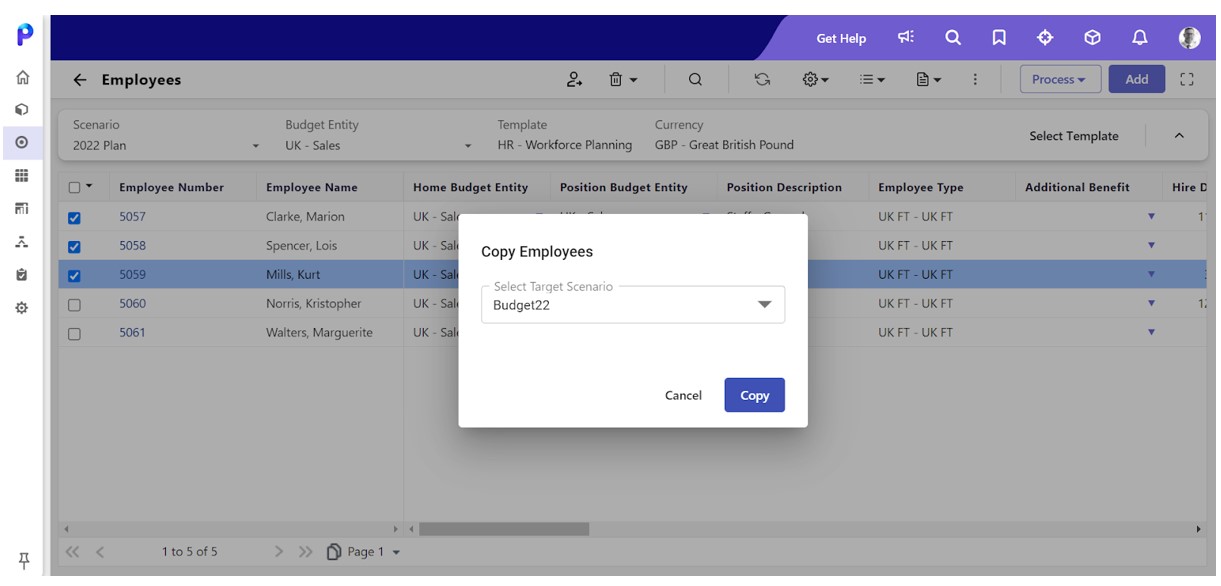
- The Copy Employees option appears after you select the employees.
- The maximum number of employees you can select at one time is 10.
- Optionally, you can use the Advanced Search option to make your search easier. Click the option, enter the search criteria, and click Apply to narrow down the search results.
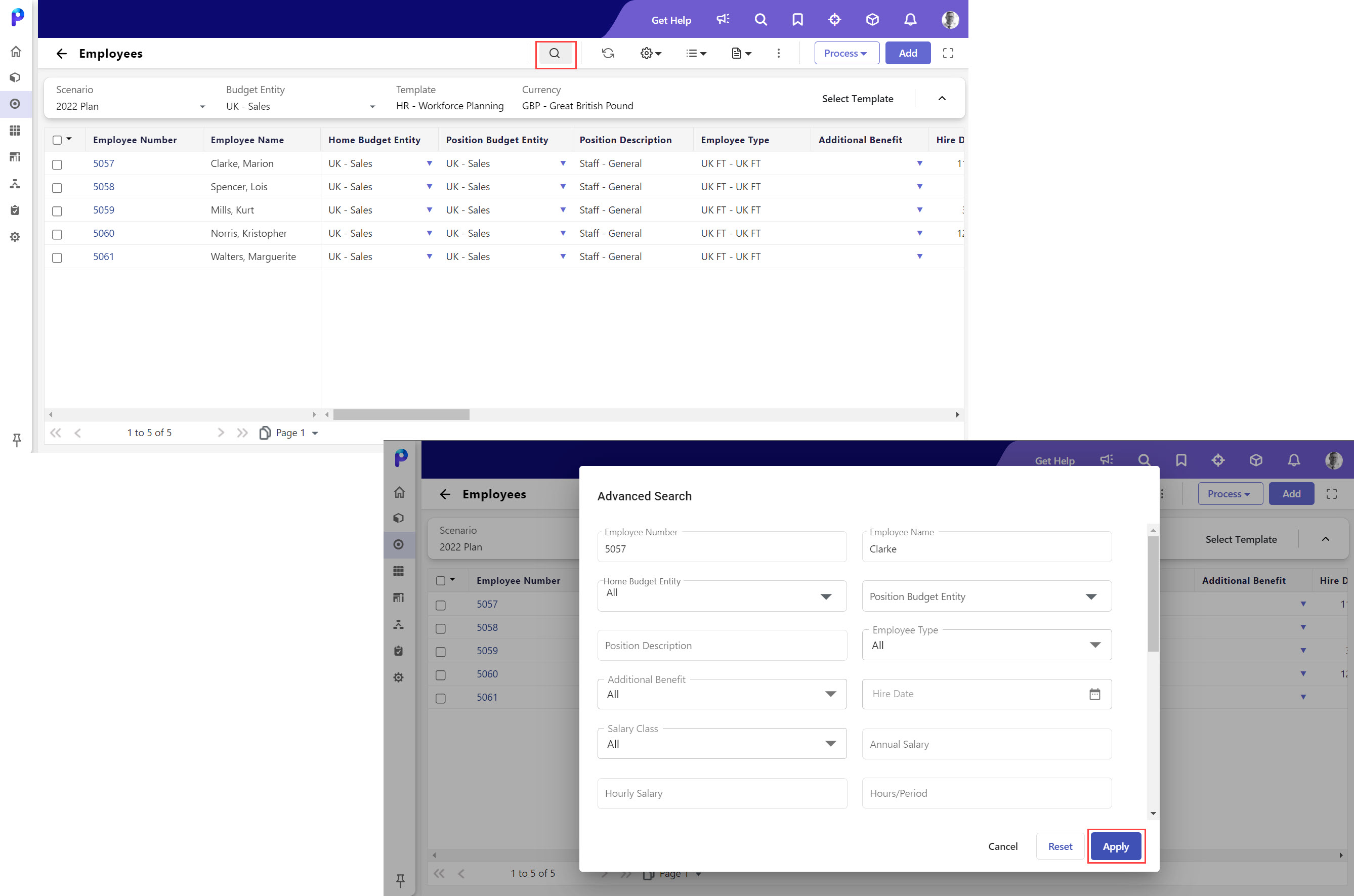
- Select the target scenario from the Select Target Scenario drop-down list and click Copy.
You will not be able to perform the copy into the locked scenarios or default scenarios.

You will see the Copy Employee Status pop-up on the screen.
- When the employees are successfully copied, you will see a notification, and if the copy process fails, you can download the report to view the error details of the failed records.

Now let’s see the criteria that help to execute the copy employees option successfully.
You should ensure that the metadata of an employee, such as Employee Types, Compensation items, and Workforce Attributes definition, must be identical in the source and target scenarios.

You should have access not only to the source scenario but also to the target scenario.
For example, the 2022 Plan is your source scenario, and the 2023 Plan is your target scenario, to which you do not have access. So now, when you copy employees from the 2022 Plan to the 2023 Plan, you cannot see the 2023 Plan listed in the Select Target Scenario drop-down list of the Copy Employees pop-up.You should have access to the budget entity mapped to the template in the target scenario. For example, you want to copy an employee record mapped to a budget entity, CANADA SALES, to the target scenario. So the copy will be successful only if you have access to this budget entity, i.e., CANADA SALES in the target scenario. You should also check that the budget entity mapped in the source scenario is mapped to the target scenario. For example, Christine is an employee, and her budget entity is mapped to CANADA SALES, and you want to copy this employee record from the 2022 Plan to the 2023 Plan. So, the copy will be successful only when the same budget entity, CANADA SALES, is mapped to the template in the target scenario.
The position description definition is unique per employee record. If an employee has multiple records with different position descriptions and you want to copy all the position records to the target scenario, then you must select all the records. You can also select one position record if you want to copy from source to target.
For example, Christine from the sales team has two designations, West Sales Manager and Sales Admin, and she has two different records with different position descriptions. So now you must select both records to copy.
Once you successfully copy from source to target, you can track all the records in the Audit log. Every single record that has been copied successfully can be seen in this log.
Notes to Remember
Let's see the use cases of when the copy employees option shows an error and how the metadata should be configured to copy successfully. We'll also look at how the copy employees option performs for some of the metadata.
Use case 1: Employee TypeWhen copying, all the definitions in the source scenario, such as Employee Type Code, Employee Type Name, and even the Compensation Items mapped to the employee type, must also be the same in the target scenario.
For example, if one of the compensation items in the below screenshot, Salaries Full time, is mapped to the employee type in the source and not to the compensation items of the employee type in the target, then the copy fails.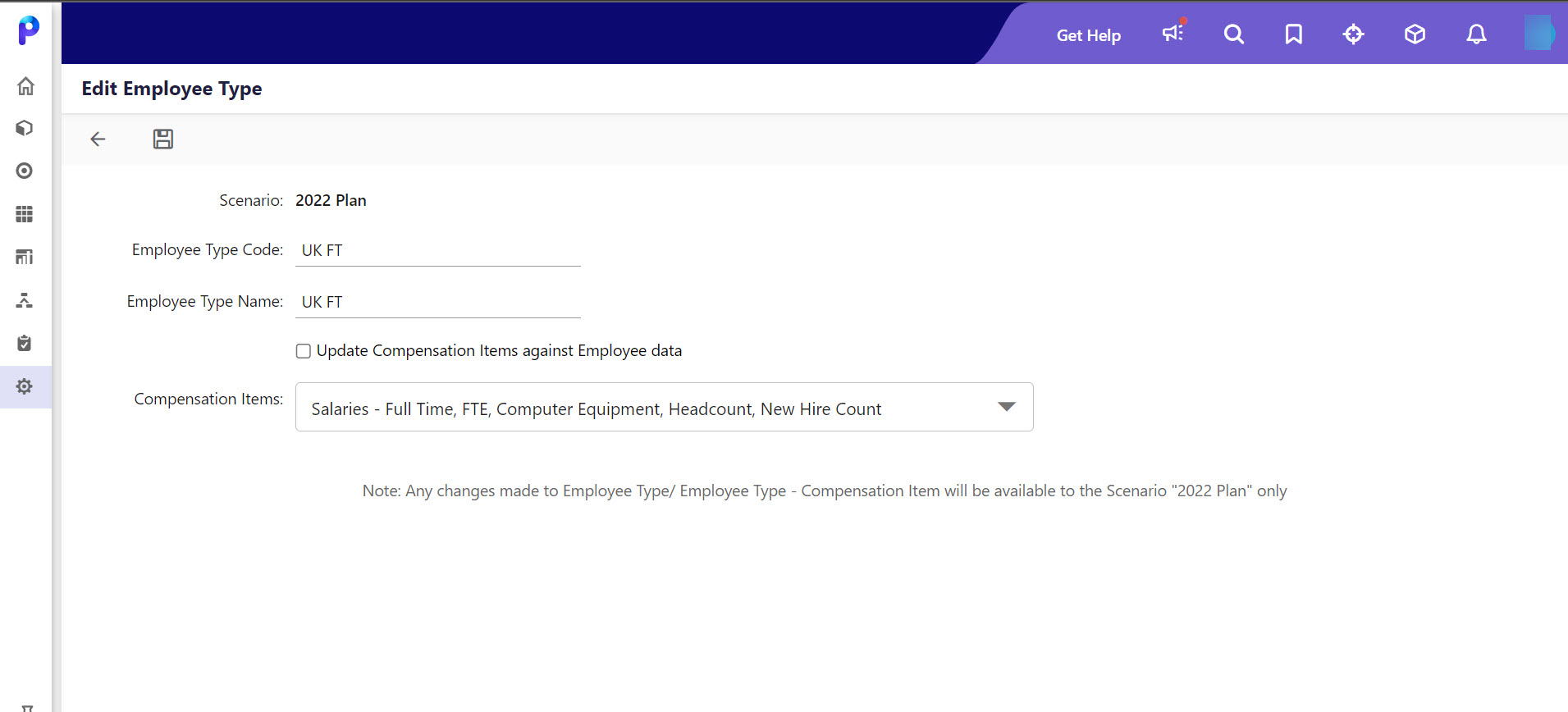
To ensure that the copy process is successful, it is always recommended to check that the compensation items mapped to an employee in the source are identical in the target scenario.
If they are available, the definitions of the General information, Compensation Basis, and Settings in the compensation items must also be the same and if they are not identical, the copy fails.
In the Compensation Basis, all definitions should be the same in both source and target. But there are some exceptions to this. For example, in the below screenshot, all the definitions must be the same except for the values defined in Amount. This is because the values defined in the Amount per Month for components in the Health Insurance Package can vary from source to target scenarios. So when you copy, it does not fail.
The Workforce Attributes' definitions should be identical in the source and target scenarios.
Let’s say there is a compensation item associated with a workforce attribute to it. To successfully copy the attribute to the target scenario, the definition of the attribute must be the same in the source and the target scenario. Any mismatch will show an error. For example, the copy will be successful only if the below Attribute Name in the source is the same in the target scenario.
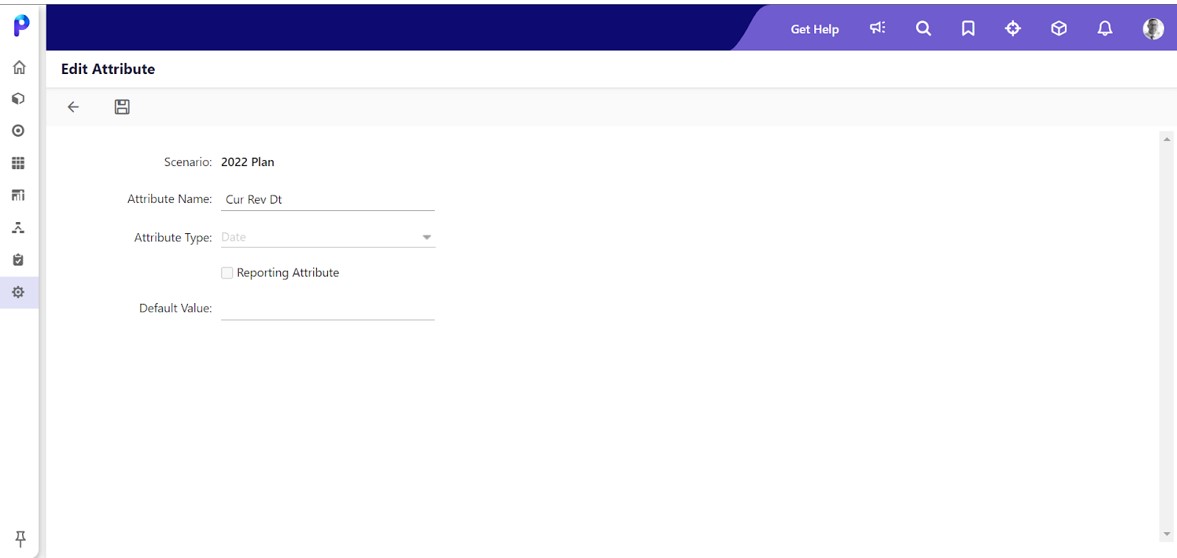
Use case 4: Allocations
Let’s see how the copy employee feature performs when copying the allocations between the source and the target scenarios.
For Non-periodic allocations:
In this process, the allocations from the source scenario are directly copied to the target scenario.
For Periodic allocations with overlapping time frames:
When copying allocations from the source to the target scenarios with overlapping time frames, it copies the values for the overlapped years. For the remaining year, it copies the allocation from the previous year. Consequently, you must manually update values for all copied employees in that remaining year in the target.
Let’s understand this with an example:
You want to copy Michael's allowances from the source scenario (2018 - 2022) to the target scenario (2019 - 2023). So, when you copy, the allowances from the overlapping period (2019 - 2022) are copied to the target. Since 2023 is the additional year, the allowance from 2022 will be copied to 2023, as shown below.
| Source | 2018 | 2019 | 2020 | 2021 | 2022 |
|---|---|---|---|---|---|
| Allowances | 1000 | 1200 | 1300 | 1400 | 1500 |
| Target | 2019 | 2020 | 2021 | 2022 | 2023 |
| Allowances | 1200 | 1300 | 1400 | 1500 | 1500 |
For Periodic allocations with no overlapping time frames:
When copying allocations from one scenario to another with no overlapping time frames, it copies and extends the values from the source to the target scenario. Consequently, you must manually update these values for all the employee records you copied into the target scenario.
Let’s understand this with an example to see how the copy happens when copying to a past-year scenario:
You want to copy Michael's allowances from the source scenario (2022 to 2026) to the target scenario (2017 to 2021). So, when you copy, the allowances from the sources year, 2022, will be copied to 2017 and extended to all the years (2018 - 2021) in the target scenario.
| Source | 2022 | 2023 | 2024 | 2025 | 2026 |
|---|---|---|---|---|---|
| Allowances | 1000 | 1200 | 1300 | 1400 | 1500 |
| Target | 2017 | 2018 | 2019 | 2020 | 2021 |
| Allowances | 1000 | 1000 | 1000 | 1000 | 1000 |
Similarly, let’s understand with an example to see how the copy happens when copying to a future-year scenario:
You want to copy Michael’s allowances from a source scenario (2017 to 2021) to a future budget scenario (2022 - 2026). So when you copy, the allowances from the sources year, 2021, will be copied to 2022 and extended to all the years (2023 - 2026) in the target scenario.
| Source | 2017 | 2018 | 2019 | 2020 | 2021 |
|---|---|---|---|---|---|
| Allowances | 1000 | 1200 | 1300 | 1400 | 1500 |
| Target | 2022 | 2023 | 2024 | 2025 | 2026 |
| Allowances | 1500 | 1500 | 1500 | 1500 | 1500 |
The Copy Employees feature works similarly for the I/P Compensation and Compensations Varying Annually when you copy from the source to the target scenarios.
Consolidation: Define Exchange Rates for Multiple Currency and Currency Types
Now define exchange rates for multiple currencies and currency types and customize the display of exchange rates on the screen.
(1).gif)
Read More...
With this release, you can define exchange rates for multiple currencies and currency types on the Currency Exchange Rates screen. You can customize the display of exchange rates with the new Customized view option. Previously, you could not define exchange rates for multiple currencies on the Currency Exchange Rates screen.
This feature helps you define exchange rates for multiple currencies in a single transaction and use the customized selection to ease the export and import of exchange rates.
You can also export the selected exchange rates for currency and currency types with the new Export Selected option or export all the exchange rates on the screen. Use the Customized view to view your customized selection or the default exchange rates on the screen and import them for other scenarios.
In Practice: How to export the customized selection of Exchange Rates
- Navigate to Maintenance> Exchange Rates> Currency Exchange Rate tab.
- Select the Default view to load all Exchange Rates or Customized view to load the previous currency and currency types combination on the screen.

- Select the Scenario, Currency, Currency Types, Year, and select the Apply Currency Conversion checkbox.

- Click the Excel icon from the menu bar.
- Select the Export Selected option from the drop-down list or select the Export All option to export all the exchange rates.

- Edit the file and save it.
- Select the Import option from the excel icon drop-down list. Import Exchange Rates pop-up will appear.
- Upload the edited excel file and click Submit.
- You will receive an email notification once the import is successful.
Consolidation: View Dynamic Journals at the Rollup Level
You can now view and post dynamic journals at the rollup level.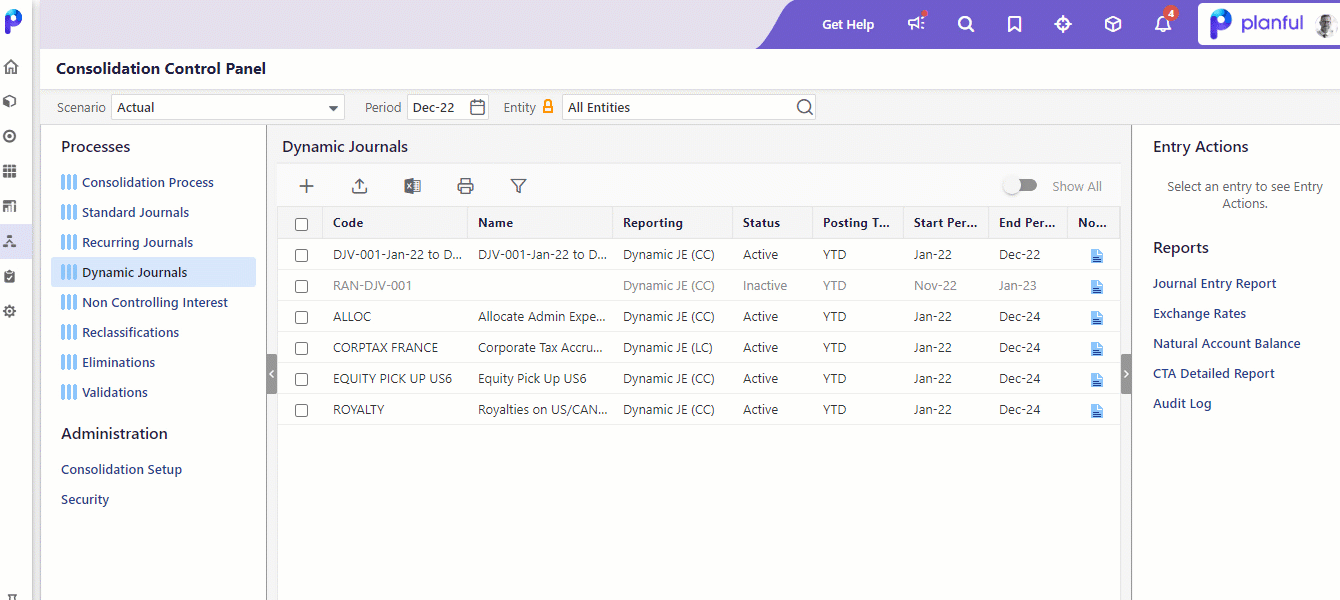
Read More...
With this release, users having access to all companies can view and post Dynamic Journals at the rollup level. Previously, there was no way for the users to view Dynamic Journals at the rollup level. Now, users can view and post Dynamic Journals for companies grouped together. Also, it facilitates the display of Dynamic Journals at the rollup level instead of viewing them at the company level.
In Practice: View Dynamic Journals at the Rollup level
- Navigate to Consolidation Control Panel> Dynamic journals.

- Select Period and Entity.
- Now, you can select the rollup level companies and post Dynamic Journals.

Consolidation: Enhanced Consolidation Process to Unlock Multiple Periods
With the enhanced Consolidation Status, unlock multiple periods with a single click!
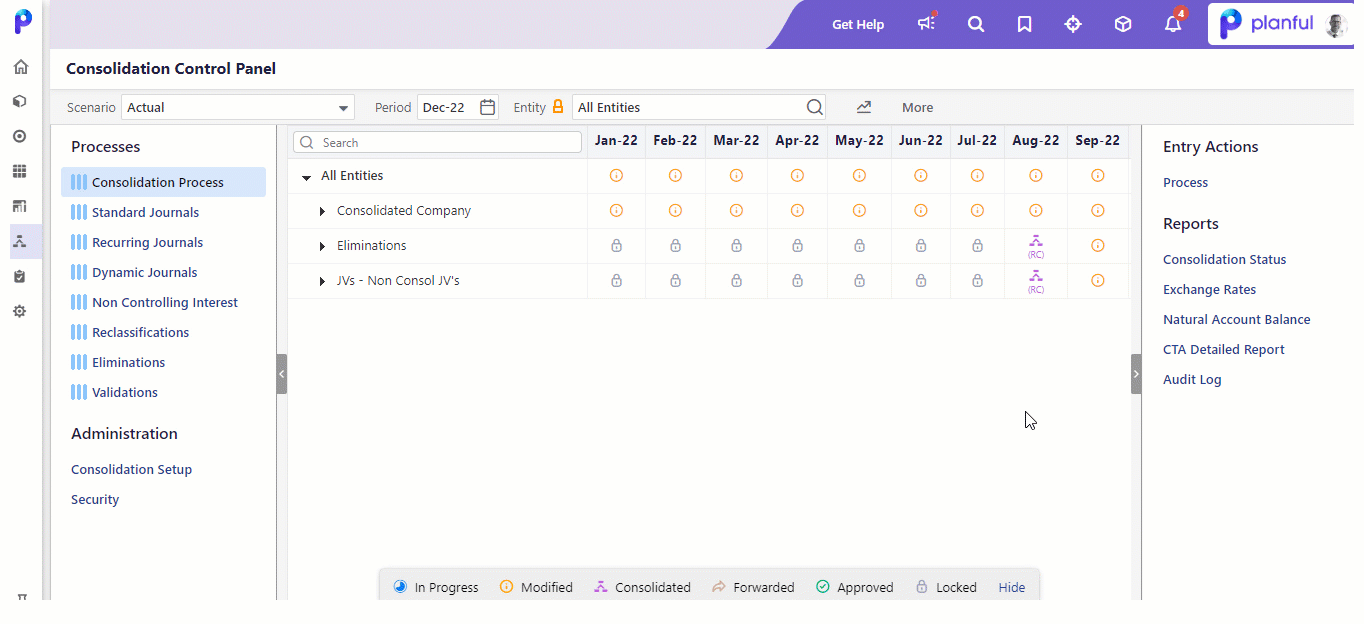
Read More...
With this release, you can unlock multiple periods in Consolidation Process with a single click. Previously, for every new company created, you had to do the tedious task of selecting each period to unlock them. This enhancement eliminates the manual clicks needed to unlock each period and makes this process simple and less time-consuming.
From the new Unlock Month window, you can quickly select the periods you want to unlock and use the Unlock button to complete the unlocking process.
In Practice: How to unlock multiple periods in Consolidation Process
- Navigate to Consolidation Control Panel> Consolidation Process.
- Select the required Scenario, Period, and Entity.
- The selected entity appears with periods.
- Select any period and click Unlock.

- The Unlock Month window appears.

- Select the required period From the calendar icon, and click Unlock.
- The selected periods are unlocked.
Consolidation: Cloud Scheduler for Standard Journals
You can now schedule the standard journal entry to post at a particular time using the new cloud scheduler!.gif)
Read More...
With this release, the Cloud Scheduler feature is now available for Standard Journals. You can schedule to post the Standard Journals on a specific day or time using the Cloud Scheduler feature. Unlike before, scheduling and automating the Standard Journals posting process avoids delays caused by manual posting.
With Cloud scheduler for Standard Journals, the application will automatically post the journals based on the scheduled time, adding convenience and consistency to the existing posting process.
Predict: Introduced Legend Panel in Reports and Templates
Predict Signals now gets a color-coded Legend Panel in Dynamic Reports and Templates. Each color code represents the following categories: High, Medium, Low, and Insufficient History.
Read more...
With this release, we have introduced a Legend Panel that displays color codes for signals in Dynamic Reports and Templates. The color codes for the signals are Red (High-Risk), Orange (Medium-Risk), Cyan (Low-Risk), and Blue (Insufficient History). To highlight a category, unselect the unwanted categories in the legend panel.
Let's understand this with an example:
User Kate wants to resolve only High-Risk signal cells from a report. With this feature, Kate can easily unselect other categories from the Legend panel and highlight only High-Risk cells marked in red. She can now select the highlighted rows and click Resolve Signals to resolve only those rows. This feature will help users like Kate in resolving Signals more efficiently.
In Practice: Viewing the Legend Panel in Templates
- Open a template.
- Click Predict> Check All Lines option from the top menu bar.
The application displays color-coded signals along with the Legend panel at the bottom of the screen.
- You can use the Legend panel to highlight the required signal category.

- If you want to hide the legend panel, click the Hide button in the legend panel, or click the Predict > Hide Legend option from the top menu bar.

- If you want to view the legend panel after hiding it, click the Predict > Show Legend option from the top menu bar.

Predict: Signals for All Lines in Dynamic Reports
With this release, we have shifted the guard rails for Signals generation in Dynamic Reports from Cell level to Line Count. The Signals for All Lines option will now be available on reports with 100 lines or less. For larger reports, you can use the Signals for Selected Lines option as before.

